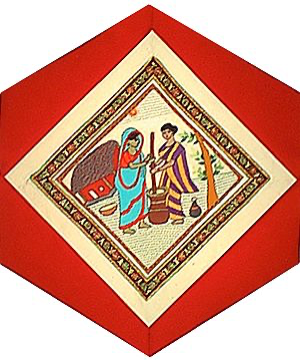Bangladesh

The Block
The Bangladesh block provides a portrait of typical village life, represented by women wearing traditional sharees and performing the daily task of pounding grain. This is a common scene in Bangladesh, where almost half of the work force is employed in the agricultural sector. The block maker, Ilora Awal, well-known in Bangladesh for her embroidery, used a simple short- and long-stitch throughout, switching to a unique stitch replicating the thatched roof found on village houses. However, it is the closely spaced lines of running stitches making up the sky and grass that clearly reflect the Bangladesh needlework tradition of nakshi-kantha. An intricately woven flowered ribbon frames the piece, which is set on a background of lightweight cotton.
Cultural Profile
Bangladesh, formerly East Pakistan, is one of the world’s most crowded nations – more than six times the population of Canada live in a country that is only twice the size of New Brunswick. About one million tribal people live in the hilly regions of Bangladesh, each tribe having its own dialect, rituals and dress. Minorities include Biharis, but the major ethnic group is Bengali. The official language Bangla (Bengali) is an important source of national pride. The Bangladeshis consider themselves to be the only people who have gone to war mainly to preserve their language. Bangladesh gained its independence in 1971. English is also spoken and used in law texts and higher education institutions, a legacy of the British colonial years in the country.
Bangladesh’s cultural heritage is deeply rooted in Islam, Hinduism, Buddhism and Christianity. Its traditional music features the bhatiali, the traditional singing of boat men. Also specific to Bangladesh and West Bengal in India are The Bauls, mystic minstrels living in rural areas and drawing from Hinduism, Buddhism, Bengali, Vaishnavism and Sufi Islam, yet refusing to identify with an organized religion or the caste system. The Bauls travel the country and sing about longing for oneness with the divine, their music being the channel to reach it. As the population of Bangladesh has shifted from rural to urban in the last decades, rock has become popular, and electric guitars are used along with more traditional instruments such as the traditional ektara used by the Bauls, or dotaras.
Festivals and celebrations are also central to the Bangladeshi culture. Some of these celebrations focus on important dates of the Muslim calendar, while others are centered on agricultural timetables, such as the Bengali New Year or the nabanno (festival of the new harvest). Bangladesh is home to the Ganges Delta, the world’s largest delta, and one of the most fertile places on earth.
Bangladesh has the second largest textile industry in the world, thanks to its large crops of jute and cotton.The country not only exports fabrics, but also makes garments that find their way in just about every chest of drawers in the world. Traditional textile arts include the weaving of jamdani, a fine muslin, and the making of nakshi-kantha, embroidered patchwork quilts often depicting village stories. Many are made for babies as it is believed that wrapping a newborn in a nakshi-kantha will bring fortune to the family and protect the child from disease. The production of pottery as well as wooden, leather and metal goods has also developed into cottage industries.
Bangladeshis have been coming to Canada since the 1970s. Previously they would have been listed as Pakistanis. Many are professionals, students or war refugees, who have settled in Ontario, Quebec, the Prairie provinces and British Columbia. Wherever they live, the 34,200 Bangladeshis listed in the 2011 census living in Canada value family and community life, where they continue to enjoy their cultural traditions, their cuisine, celebrate special holidays and practice their faith.
Sponsor: Mary Anderson Marouf and Kazi Marouf
